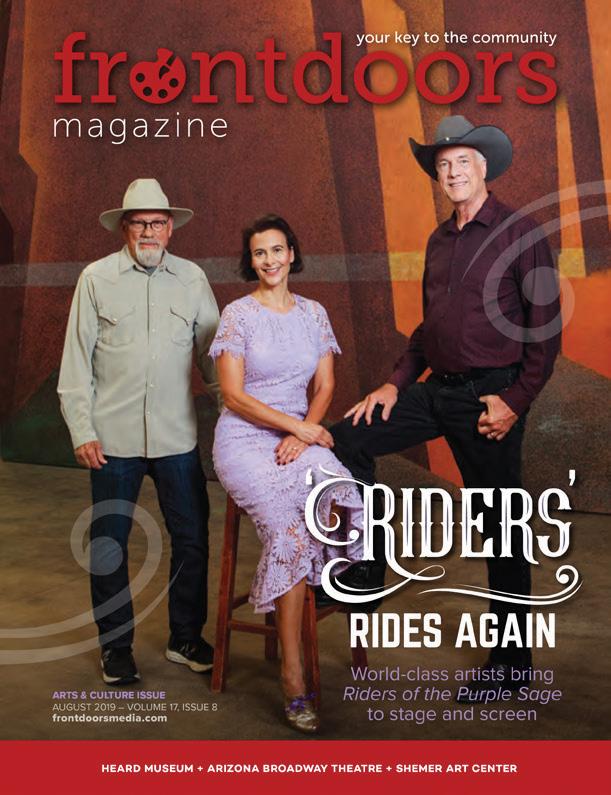
9 minute read
ECOSYSTEM EXTINCTION
ECOSYSTEM EXTINCTION THE POSSIBLE GRIM FATE OF WILD MUSTANGS IN ARIZONA
BY IVY CIOLLI E arth Day falls on April 22 each year, and 2020 marks the 50th anniversary of the birth of the modern environmental movement. The 1970s were apparently the awakening of more environmentally conscious minds, but sadly, half a century later, we’re still struggling to uphold the movements and legislation meant to protect Mother Earth and all its inhabitants.
On this milestone Earth Day, turn your thoughts to the importance of our ecosystem. In a natural, healthy ecosystem there is a balance between predator and prey, with each regulating the numbers of the other. But when humans interfere by killing off too many of the natural predators, the result is unnaturally inflated numbers of prey species, which then leads to overgrazing, damage to the environment, and eventually mass starvation.
This overgrazing has become the fate of the wildlife that dwell on the land designated to the cattle ranchers—and can possibly lead to the extinction of wild mustangs. For these horses, their future looks grim. Many end up at slaughter houses in Mexico or Canada, some are held in ranchers' lucrative holding pens, and only the lucky few find their way to sanctuaries who have to strategically bid to buy them at auction. With this issue at the forefront of my mind, it’s our future generation that keeps me motivated to draw attention around such a controversial topic.
While skiing with my family in Park City, Utah recently, a horse-loving 10-year-old girl took the chairlift up with us on our first run. When she learned that we lived in Arizona, she immediately asked if we get to see wild horses on a regular basis. I explained to her when driving in the mountains, especially near the Salt River, you can be fortunate to see a herd of wild mustangs. Although, the reality is you may not be able to see them in the wild for long. I didn’t say this because I couldn’t bear to tell her that they are in imminent danger of losing their freedom. Instead, young children like her are put in my path to remind me to keep speaking up for the voiceless. As a child, I grew up horseback riding and had a horse named Bandit that my father saved from being euthanized. The highlight of my childhood was taking English riding lessons at a barn near my home, and on occasion, riding Western on a family friend’s ranch. In addition, my chiropractic father
would adjust horses with a rubber mallet every Tuesday free of charge. Needless to say, I come from a family of horse lovers! I am a huge advocate of equine therapy for people of all ages at barns such as Hunkapi Programs in Scottsdale, where horses rescued from slaughter heal people as much as the people heal the horses. I am also a supporter of horse rescues such as Healing Hearts in Cave Creek. Working to save Arizona's wild horses is nothing new according to Jennifer Brumbaugh, executive director at Healing Hearts, who shares that, “In 2018, news from Arizona's Navajo Nation was shocking. Nearly 200 wild horses were found dead near a dried-out stock pond. While searching for a water source, these desperate horses burrowed themselves into the mud and couldn’t escape. It was a horrific sight. Yet, three lone newborn foals survived, and were taken to Healing Hearts for rehabilitation. Shared water sources with cattle and drought were factors in this horrific event.”
As you begin to understand my passion for wild mustangs, you may or may not be aware of the impact of cattle ranchers, licensed killings of predators, and the natural migration of wild mustangs on government land that is now allocated to cattle ranchers for grazing purposes. I am constantly following the news regarding the wild mustang round-ups and removal from government lands managed by the Bureau of Land Management (BLM). It's the division of the government meant to protect them, yet it’s the cattle ranchers whose interests they’re actually looking out for.
Grace Kuhn wrote a poignant article in the Salt Lake Tribune stating that across the West, cattlemen graze their private livestock on our public lands. The grazing fee remains at $1.35 per month per cow/calf pair, which is the minimum allowed under the current law. This is a 90 percent discount with gratitude to tax subsidies. The public lands livestock program produces only 1.9% of our nation’s beef, yet has cost taxpayers more than $1 billion over the past decade.
Kuhn stated, ”Keep in mind: The vast majority of the time, the taxpayer is not supplementing small family ranches; rather we’re footing the bill for large corporations taking advantage of a federal program.” Hence why they view wild horses as their competition encroaching on cheap, subsidized grazing land. The BLM estimates that there are around 88,000 wild horses on Western public lands, while there’s 700,000 to a million For these horses, their future looks grim. Many end up at slaughter houses in Mexico or Canada, some are held in ranchers' lucrative holding pens, and only the lucky few find their way to sanctuaries who have to strategically bid to buy them at auction.

grazing cattle. These wild horses are allotted just 17 percent of federal rangelands to inhabit. Of this, an astounding 80 percent is designated for privately owned livestock.
Those statistics and facts are heartrending, especially when I read on www.americanwildmustangcampaign.org that in 1971, Congress unanimously passed the Wild Free-Roaming Horses and Burros Act, a federal law to protect wild horses and burros from “capture, branding, harassment, and death.” Declared “living symbols of the historic and pioneer spirit of the West; that they contribute to the diversity of life forms within the Nation and enrich the lives of the American people;

and that these horses and burros are fast disappearing from the American scene.”
The BLM, which exists as an agency within the U.S. Department of the Interior, was charged with managing these animals on public lands. Sadly, this protection does not exist today. The reality is that the BLM uses low-flying helicopters to brutally stampede, capture, and remove wild horses and burros by the thousands from Western public lands. Wild horses and burros who survive roundups are stockpiled in government holding facilities. Those who can’t be adopted or auctioned off are sentenced to a lifetime of being warehoused in long-term holding facilities. At the very worst, wild horses end up in the slaughter pipeline.
According to the same site, approximately 80 million taxpayer dollars fund this mismanaged program annually.
These are facts that many are not privy to unless you start delving in and researching on your own. Needless to say, ranchers want public lands clear of any animals that inhibit their profits such as wolves, bison, mountain lions, and coyotes. In 2018, agents killed 2.6 million animals, including 375 mountain lions. The USDA will kill any predators that enter public land upon a rancher's request just because they are present on their grazing allotments. Mountain lions are natural predators of wild horses and burros. These apex
greenliving | April 2020 predators balance ecosystems and could help to regulate wild horse populations. But between hunting tags and government kill programs aimed at protecting livestock, hundreds of mountain lions are killed on public lands each year. Needless to say, if wild horses do not have predators; their population will continue to grow. But if we allow nature to take its course, the wild horse population would remain under control and endangered wildlife would not have to pay the ultimate price of extinction. Our ecosystem only functions properly when we allow these animals to live their natural lives in their natural habitat ensuring food and fertile land.
The impact of humans interfering with nature is undeniable. Our eco-system is suffering as a result. The demise of wild horses and other wildlife is inevitable unless we take a stand. It is my hope as well as many other to keep these wild horse bands intact and preserve their freedom before it’s too late. I have become very fond of a wild mustang sanctuary called Skydog Ranch, located in Oregon, that I hope to emulate one day. The founder’s mission is to try to keep these herds together and reunite families that otherwise would be split up and most likely sent to auctions where kill buyers are eager to sell them to Mexico and Canada for consumption.
Clare Staples, the founder of Skydog Ranch, kindly took time away from her daily routine of caring for these wild mustangs to give me the statement, “Right now, wild horses are being managed to extinction by the government agency mandated to care for them on public lands. If we continue like this, there will be no mustangs left for future generations—sold out for greed and profit and the almighty dollar. But they are worth so much more as their wild and free spirits represent everything good about the American West. We are doing all we can to raise awareness for them and urge others to take action to help them before it’s too late.”
Earth Day 1970 was the emergence of advocates for the wellbeing of our planet—now in 2020, live in the spirit of Earth Day every day by being the voice for wild mustangs and all wildlife on the brink of extinction. Trust that Mother Nature knows how to innately balance our ecosystem; all who rise from the soil resolve back to the soil in harmony.
Visit www.healingheartsaz.org/, www.skydogranch.org and www.americanwildhorsecampaign.org/ for the latest update on wild mustang Roundups and the SAFE Act (H.R. 961, Safeguard American Food Exports Act).
Any opinions expressed in articles are the writer’s.
Ivy Ciolli is a native of Arizona born with the innate desire to protect Mother Earth. She is a wife and proud mother of Cole and Brooklyn. Her days are filled with volunteering at her children's school, and philanthropic work involving abused and neglected children and animals.
Need aNew WebsiteFast?










Launchyoursiteinassoonasaweek Workwithourprofessional designteam Choosefrom30+industry-tailored templates
Getstarted atFasturtle.com
Only $995
JULY 2019 – THE EDUCATION ISSUE VOLUME 17, ISSUE 7 HOLIDAY GIVING DECEMBER 2019 - VOLUME 17, ISSUE 12
Heart Treasures of the
KURT AND BRENDA WARNER HAVE TURNED LIFE’S CHALLENGES INTO AN ENDURING DRIVE TO GIVE



HOLIDAY GIFTS THAT GIVE BACK + CARDS FOR KIDS + THE ANTHONY BATES FOUNDATION
JANUARY 2020, VOLUME 18, ISSUE 1
Learning
EARNING From to Junior Achievement of Arizona gives kids the skills they need to succeed
EXPECT MORE ARIZONA + GENESIS CITY + ASSISTANCE LEAGUE OF PHOENIX
FRD 27919 July Magazine_FIN2.indd 1 7/2/19 5:27 PM
Celebrating the people and groups who give generously and work to build the future of our community.
A MOTHER’S
Dream
FOUR SISTERS UNITE TO FIGHT OVARIAN CANCER
FEEDING MATTERS + ARIZONA COMMUNITY FOUNDATION + TEEN LIFELINE
FRONTDOORS MAGAZINE + THE KNOCK + FRONTDOORS TV WITH CAREY PEÑA frontdoorsmedia.com










